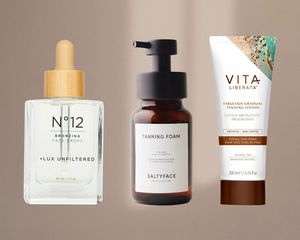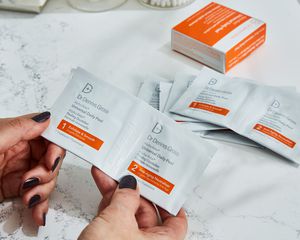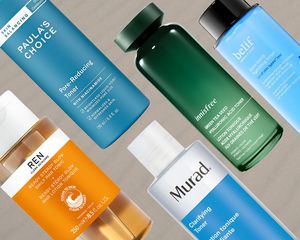:max_bytes(150000):strip_icc()/azelaicacid1-51f51ffb31284c0ea5558794b37d9bae.png)
Stocksy
Exfoliating acids are the foundation of any healthy skincare routine, and for good reason. They help people achieve clear and healthy skin by sloughing away dead skin cells, unclog pores, brighten skin, reduce acne-causing bacteria, soothe irritation, and even minimize hyperpigmentation. In short, they're amazing ingredients, but it's important to know how often to use them to prevent flaking, dryness, and irritation, which ones work best for your skin type. One of the most popular ingredients is azelaic acid, which dermatologists praise and popularly recommend.
Unlike most other acids, azelaic acid is neither an alpha-hydroxy acid (AHA) or a beta-hydroxy acid (BHA). It comes from naturally-occurring yeast (that grows on the skin) and is milder than most AHAs and BHAs. As such, it's much milder on the skin than AHAs and BHAs and rarely causes a reaction. In fact, even those with sensitive skin types and inflammatory skin conditions, such as eczema and rosacea, are able to use it
To best understand how to use this hero ingredient, we tapped two board-certified dermatologists to ask them all our questions. Below, they share everything there is to know about azelaic acid's versatility and multi-purpose usage, and what to factor in should you decide to use it.
Meet the Expert
- Francesa Fusco, MD, is an NYC-based dermatologist who specializes in dermatologic surgery.
- Gervaise Gerstner, MD, is a board-certified dermatologist for over 17 years specializing in laser treatment, microneedling, Botox, and fillers.
What Is Azelaic Acid?
In short, Gerstner says azelaic acid is a dicarboxylic acid that helps exfoliate the skin and is synthesized by yeast naturally, but it can be derived from several places. "Azelaic acid is produced naturally on your skin by yeast, but you can also make it in a laboratory, and it can come from grains and cereals," Fusco says. In addition to being comedolytic (meaning it prevents comedones - blackheads) and working to exfoliate deep within the pores, Fusco says azelaic acid is also keratolytic (breaks down excess keratin), anti-inflammatory, and has antioxidant properties. Like we said, it's an overachiever.
Azelaic Acid
Type of ingredient: Acid/Exfoliant
Main benefits: Fights acne, treats rosacea, lightens dark spots, and removes dead skin cells.
Who should use it: In general, anyone with acne-prone, rosacea-prone skin, and hyperpigmentation. Fusco says azelaic acid is recommended for all skin types and is even safe for those who are pregnant.
How often can you use it: It is safe to use twice a day (morning and night) or once every other day for those with sensitive skin.
Works well with: Alpha-hydroxy acids (AHA), beta-hydroxy acid (BHA), and retinol.
Don't use with: Azelaic acid is safe to use in conjunction with most if not all, ingredients.
Though Fusco and Gerstner recommend a prescription form of azelaic acid to their patients (either Finacea or Azelex) in a strength of 15 percent to 20 percent respectively, it's also available over the counter in a lower strength of 10 percent or less. Azelaic acid can be found in leave-on topical treatments and comes in gel, foam, and cream forms, which are designed to be used on different areas of the body. For instance, the foam version is better suited to cover a larger area like the back than a small cream or gel would be.
Benefits of Azelaic Acid for Skin
Azelaic acid is a multifunctional skincare ingredient that tackles a multitude of concerns related to breakouts and inflammation:
- Gently exfoliates: It goes deep within the pores and removes dead skin cells that cause dull skin tone and clogged pores.
- Fights acne: It has antibacterial properties, and according to Fusco, it's reported to be bactericidal (meaning it kills bacteria) to P. acnes, which leads to acne.
- Reduces inflammation: Azelaic acid soothes irritation and helps to improve red bumps caused by inflammation.
- Evens skin tone: It inhibits tyrosinase, which is an enzyme that leads to hyperpigmentation. It's effective on post-inflammatory hyperpigmentation from acne breakouts and can affect melasma as well.
- Treats rosacea: Azelaic acid could help with pore-clogging, inflammation, and secondary infections caused by rosacea: "It’s a less irritating option, which is why we use it for rosacea because the skin tends to be very sensitive," Gerstner says.
- Is safe for pregnant women: Fusco says azelaic acid is one of the few treatment options for acne, rosacea, clogged pores, or pigmentation that is generally safe for pregnant women.
- Is gluten-free: Despite being wheat-derived, Fusco says most gastroenterologists agree that it likely can’t be absorbed significantly enough through your skin to trigger a gluten sensitivity or reaction.
- Could be helpful with alopecia: "There have been some reports suggesting that it could help treat alopecia or hair loss," Fusco says. "Some doctors are having pharmacists incorporate it into their hair products because it might help to grow hair."
Potential Side Effects of Azelaic Acid
It is possible to experience slight irritation, such as stinging or tingling, when using azelaic acid. If the side effects get severe, including swelling of the face, difficulty swallowing or breathing, and hives, it should be brought to the attention of your doctor as it may indicate an allergy.
Overall, Fusco and Gerstner say they do not find that their patients have adverse reactions to it and that by and large, it's a mild type of acid.
How to Use Azelaic Acid
Whether you're using an OTC formula or a prescription, Gerstner suggests applying a thin layer of the product to clean, dry skin twice a day, morning and night. For someone with sensitive skin, she recommends using it once every other day.
For any type of azelaic acid product you use (foam, gel, or cream), apply it to your face and neck using a pea- or marble-size amount spread evenly over the area after you finish cleansing. Product-wise, we recommend SkinCeutical's Phyto A+ Brightening Treatment, The Ordinary's Azelaic Acid 10% Suspension Brightening Cream, and Paula's Choice's 10% Azelaic Acid Booster.
To help the azelaic acid absorb and perform even more effectively, Fusco recommends applying your AHA (like glycolic or lactic acid), BHA (salicylic acid), or retinol first to open up the skin and accept the azelaic acid more readily. Then, follow with a hydrating moisturizer and a sunscreen with SPF of at least 30 in the morning.


